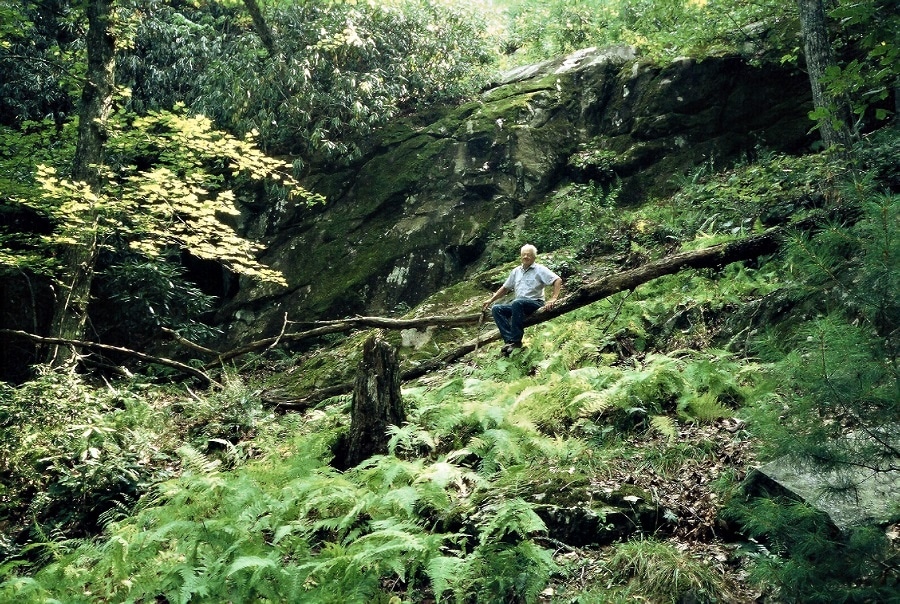More than One Century

Conservationist John Humphrey takes the long view
John Humphrey, who is 102, has lived on his farm near Mills River for over half a century. He has devoted countless hours to hands-on stewardship of his woods, and you can still find him out in the forest cutting or uprooting invasive plants like multiflora rose, bittersweet, privet, and barberry.
“We finally got him last year to give up his chainsaw,” says his son David, who lives on the farm, next door to John.
John protected his land with a conservation easement over 20 years ago—the first easement ever donated to Conserving Carolina. He can point out many reasons why this land should be protected. The farm, which is mostly forested, buffers Pisgah National Forest. It lies in a beautiful valley along the road to the forest entrance. There’s a mountain bog—a rare habitat. There are numerous seeps and springs that form the headwaters of Foster Creek, which flows into the Mills River—the water source for much of Henderson County.
But those reasons don’t fully capture his sense of why he needed to protect the land. On a bright February morning, looking out from his deck across a green field to a ridge covered in forests, John pauses before answering the question, “Why is it important to protect this?”
“Because it belongs here,” he answers, at last. “It’s been here longer than I have.”
Video: Ever heard a 102-year-old man reflect on 500 year old trees? Here’s your chance.
A Place in the Country
John served in World War II as a Navy captain before returning to his career as a chemical engineer. When work brought him to Asheville in the mid-1960s with his late wife Ruth, he started looking for a place in the country—where they could enjoy some open space, where Ruth could ride horses, where they could raise the youngest two of their five children.

David, their oldest child, says, “They always enjoyed rural property and the feeling of not being hemmed in.” This valley reminded Ruth of a farm where they had lived in Pennsylvania—where David grew up, helping to raise cows, pigs, and chickens. “I can remember my mother saying it reminded her so much of the farm in Pennsylvania.” he says. “When they found this place in North Carolina, she fell in love with it.”
But they worried, as suburban neighborhoods spread out from Asheville. Ruth would wake up in the night, full of anxiety that sprawl might overtake their lovely valley. “We had visions of looking out the window at a sea of roofs,” John says. “We didn’t like that.”
So they started reaching out to local conservation organizations. Eventually, in 1996, they donated a conservation easement on their 181 acres to Conserving Carolina, then known as Carolina Mountain Land Conservancy. It was the land trust’s first easement—to be followed by nearly 220 more in the decades that followed. By donating the easement, the Humphreys limited the development rights that go with their land, protecting it forever as a place for forests, farmland, wetlands, and wildlife.
In the Boardroom and the Forest
The farm is not at all like where John grew up. As a child, he could see the Statue of Liberty from his yard, in the suburbs of northern New Jersey. But he credits his experiences at summer camp—first as a camper, then working summer jobs—with fostering his connection to the outdoors.
As a conservationist, John went far beyond protecting his own land. He served multiple terms on the board of Conserving Carolina, including two terms as president. Under his leadership, the land trust hired the current executive director, Kieran Roe, and started AmeriCorps Project Conserve, which now places 41 members with 18 conservation organizations in Western North Carolina. It grew relationships and credibility that allowed it to help protect over 45,000 acres, so far.
John’s dedication shows in the forest as well as the boardroom. Eradicating invasives in his woods allows diverse plants and wildlife to flourish—rather than an overgrowth of vines or bramble. But it’s a tireless job, cutting back the larger plants, then controlling the countless sprouts that come up.
“If you make some headway,” he says, “it’s very slow and you have to keep at it. And if you let it go for a few years, you kind of have to start over again. And the problem is, we’ve got climate change to deal with. And the invasives have adapted and taken over. They’re just part of the landscape—I’m not sure that we’re ever going to get rid of them, but we might reduce their impact considerably.”
It’s a campaign that he’s kept up with surprising vigor well past his hundredth birthday, although he has been slowing down some recently.
David, in some ways, is following in his father’s footsteps. He serves on Conserving Carolina’s board, as treasurer. David says, “Like him, I love being in the woods. I enjoy working in the woods. Working to control invasives is a wonderful way to spend time outdoors and get some exercise and feel like you’re doing something constructive.”

Working with John
The Humphreys got some help when Conserving Carolina helped to secure grants from the U.S Fish and Wildlife Service and U.S. Forest Service to control non-native plants around the bog. The Humphreys hired a contractor who specializes in invasive plant management, Jane Hargreaves, who has since become a friend. Conserving Carolina staff and volunteers also lend a hand at regular workdays.
“They’re my favorite workdays,” says Olivia Dannemiller, an AmeriCorps member who manages Conserving Carolina’s volunteer program. “I feel like he cares so much about it and I just like volunteering with him. And Jane has such a passion for it too—it’s nice to do it with these super dedicated people.”
Some volunteers come out because they like to work with John. “He does everything we do, if not more,” Olivia says. “He knows all of the plants and uses the same tools as us and removes as much as your typical volunteer would during the day. Sometimes he works longer than we do.”
“It’s awesome to work with a 102 year old,” she says. “Who knows when I will have that chance again?”
Young for a Tree
The trees on the Humphrey farm are about the same age as John. Around a hundred years ago, the land was timbered and the forests have been growing back since then. But, while a century is a long lifespan for a person, it’s young for a tree.
John is an avid reader and recently he came across some ideas that intrigued him in The Hidden Life of Trees by Peter Wohlleben.
He says, “Something I’ve been trying to come to grips with is that in terms of the natural state of things, these forests apparently are really full of young trees. That means that some of them are approaching 100 years old. In terms of the natural state of things, that’s still only approaching adulthood.
“I’ve been reading a book by a German forester and he talks about forests that are full of 500-year-old beech trees. And he says that these trees actually communicate with one another with their root systems and their systems of fungi in the ground. And that the biggest trees act as parents of the younger trees and provide supporting assistance through these underground networks.”
John looks out at his forests and pictures stewardship that goes beyond one human lifetime. “I can’t imagine if this area was allowed to stay around and be taken care of to where the trees are 500 years old.”

This article is by Rose Jenkins Lane, the communications director for Conserving Carolina. She writes the monthly Stories of the Land series which is published in the Hendersonville Times-News.